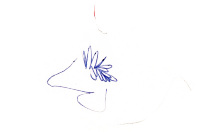Ana Vaz

Ana Vaz
2020, 32min, Portugal

Ana Vaz
2020, 32min, Portugal

13 Ways Of Looking At a Blackbird
13 Ways Of Looking At a Blackbird
Taking its title from the poem by Wallace Stevens “13 Ways of Looking at a Blackbird,” the film is composed of a series of attempts at looking and being looked at. Beginning as a city state commission under the name and attitude of Unschool, the film became a kaleidoscope of the experiences, questions, and wonders of a couple of high school students after a year of experiences with filmmaker Ana Vaz, questioning what cinema can be. Here the camera becomes an instrument of inquiry, a pencil, a song. “The film is a song you can see,” wrote one of the students in a collective constellation of phrases and drawings made during one of the workshops. The phrase is a perfect description of a film that explores a nascent ecology of the senses. From https://www.berlinale.de/en/programme/202111140.html
Production Company: Galerias Municipais de Lisboa — EGEAC
Co-production: Stenar Projects (Lisboa, Portugal)
Directed by: Ana Vaz
Images and dialogues: Ana Vaz, Vera Amaral, Mário Neto, Paula Nascimento
Sound Design: Mário Neto, Nuno da Luz, Catarina Boieiro
Montage by: Ana Vaz
Reading: Paula Nascimento
Colaboration with highschool students: Vera Amaral and Mário Neto
Berlinale Forum Expanded 2021
ARTIST'S BIOGRAPHY
ARTIST'S BIOGRAPHY
|
Créditos: Foto de Michiel Devijver |
Ana Vaz, born in 1986 in Brasilia, Brazil, is an artist, filmmaker, and founder of the in(ter)disciplinary collective COYOTE. Her film-poems are underpinned by experimental collages of images and sounds, discovered and produced, to reflect upon situations and contexts which are historically and geographically marked by narratives of violence and repression. Expansions or consequences of her films, her practice may also be embodied in writing, critical pedagogy, installations, film programs, or ephemeral events. In 2015, she was the recipient of the Kazuko Trust Award presented by the Film Society of Lincoln Center in recognition of artistic excellence and innovation in her moving-image work. From https://www.berlinale.de/en/programme/202111140.html |
FILMOGRAPHY
Sacris Pulso - (2007, 15min)
Entre Temps - (2012, 12min)
Les Mains, Negatives - Ana Vaz e Julien Creuzet - (2012, 15min)
A Idade da Pedra - (2013, 30min)
Occidente - (2014, 15min)
A Film, Reclaimed - Ana Vaz e Tristan Bera - (2015, 19min)
Ha Terra! - (2016, 12min)
Amerika: Bahia de Las Flechas - (2016, 8min)
Olhe Bem As Montanhas - (2018, 30min)
Amazing Fantasy - (2018, 3min)
Atomic Garden - (2018, 8min)
Apiyemiyeki!? - (2019, 28min)
Pseudosphynx - (2020, 9min)

INTERVIEW WITH ANA VAZ ABOUT “13 WAYS OF LOOKING AT A BLACKBIRD”
WATCH THE SHORT FILM “PSEUDOSPHYNX” (2020), by Ana Vaz - Instituto Moreira Salles
INTERVIEW WITH ANA VAZ ABOUT “OCCIDENTE” - Vdrome
ANA VAZ PORTFOLIO - Even Magazine
ARTICLE “AR, FOGO, TERRA E ÁGUA - O CINEMA DE ANA VAZ” - A Cuarta Parede

***
ABOUT THE MOVIE “APIYEMIYEKÎ?” (2019)


Brazil / France / Nederlands / Portugal
16mm transferred to 2K, 27’33’’, 2019
SINOPSIS
Apiyemiyekî? was a part of the exhibition called Meta-Arquivo 1964-1985: Espaço de Escuta e Leitura das Histórias da Ditadura Militar no Brasil [Space of Listening and Reading the Stories of the Military Dictatorship in Brazil], at Sesc Belenzinho, in São Paulo, which brought together a series of unpublished works dedicated to the construction of a cosmology that criticized this period. The film is a cinematic portrait that starts from the archives of Egydio Schwade, a Brazilian educator and activist for the rights of indigenous peoples - Casa da Cultura de Urubuí, located in his house, in Presidente Figueiredo (Amazonas), where are currently preserved more than 3,000 drawings made by the Waimiri-Atroari, a native people of the Brazilian Amazon, during their first literacy experience. Based on the critical pedagogy of Brazilian educator and philosopher Paulo Freire, the drawings became one of the first methods of exchange and reciprocal production of knowledge. During the literacy exercises, the question that was most frequently raised by the Waimiri-Atroari was: Why did Kamña ("the civilized") kill Kiña (Waimiri-Atraori)? Apiyemiyekî? (Why?).
The drawings make up a collective visual memory from their experience of learning, perspective, and territory, as they witness a series of violent attacks suffered by the Waimiri-Atroari people during the military dictatorship. Apiyemiyekî? animates and transposes the drawings to the landscapes and scenarios they narrate, seeking to echo their recurring question and trusting that memory is truly an engine most necessary to build a common future.










 - 13 Ways of Looking at a Blackbird.jpg)